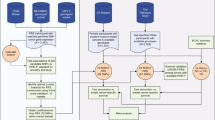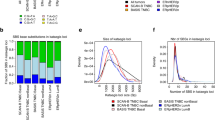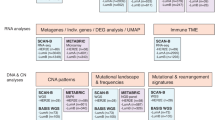Abstract
Genome-wide association studies have identified a single-nucleotide polymorphism (SNP) to be associated with an increased risk of breast cancer. The biology of one of the susceptibility locus C6ORF-ESR1 and whether it also contributes to progression of established disease has not yet been ascertained. We examined the association of rs2046210 and its six linkage disequilibrium SNPs with clinicopathological characteristics, prognosis, and gene expression levels of ESR1 and the C6ORFs (C6ORF97:CCDC170, C6ORF211, C6ORF96:RMND1) in 344 breast cancer tissue samples and 253 corresponding samples of adjacent normal tissue. Tumor genotypes with homozygous risk alleles were more frequent than normal tissues. The tumor genotypes of rs2046210 and rs6929137 with homozygous risk alleles showed worse relapse-free survival (RFS, P=0.038 and P=0.031, respectively), whereas no notable associations were observed with either clinicopathological characteristics or expression of the peripheral genes. Higher C6ORF97 expression correlated with ER negativity (P<0.0001), highly proliferative characteristics (P=0.0005 for Ki67, P<0.0001 for nuclear grade) and worse RFS in the ER+/HER2− cohort (P=0.013), whereas the other two C6ORFs showed the inverse associations. Furthermore, C6ORF97 showed significant worse prognostic values especially in luminal B subtype in the publically available data sets. rs2046210 and the upstream gene C6ORF97 might have substantial roles not only in carcinogenesis but also in progression toward a more aggressive phenotype in breast cancer patients, which suggests that functional studies of this locus are imperative.
Similar content being viewed by others
Log in or create a free account to read this content
Gain free access to this article, as well as selected content from this journal and more on nature.com
or
References
Germain D : Estrogen carcinogenesis in breast cancer. Endocrin Metab Clin 2011; 40: 473–484
Zheng W, Long J, Gao YT et al: Genome-wide association study identifies a new breast cancer susceptibility locus at 6q25.1. Nat Genet 2009; 41: 324–328.
Turnbull C, Ahmed S, Morrison J et al: Genome-wide association study identifies five new breast cancer susceptibility loci. Nat Genet 2010; 42: 504–507.
Sueta A, Ito H, Kawase T et al: A genetic risk predictor for breast cancer using a combination of low-penetrance polymorphisms in a Japanese population. Breast Cancer Res Treat 2012; 132: 711–721.
Cai Q, Wen W, Qu S et al: Replication and functional genomic analyses of the breast cancer susceptibility locus at 6q25.1 generalize its importance in women of chinese, Japanese, and European ancestry. Cancer Res 2011; 71: 1344–1355.
Stacey SN, Sulem P, Zanon C et al: Ancestry-shift refinement mapping of the C6orf97-ESR1 breast cancer susceptibility locus. PLoS Genet 2010; 6: e1001029.
Drury S, Johnson N, Salter J et al: A breast cancer-associated SNP Adjacent to ESR1 correlated with oestrogen receptor-alpha level in invasive breast tumors. PLoS Genet 2011; 7: e1001382.
Dunbier AK, Anderson H, Ghazoui Z et al: ESR1 is co-expressed with closely adjacent uncharacterised genes spanning a breast cancer susceptibility locus at 6q25.1. PLoS Genet 2011; 7: e1001382.
McShane LM, Altman DG, Sauerbrei W et al: REporting recommendations for tumour MARKer prognostic studies (REMARK). Eur J Cancer (Oxford, England: 1990) 2005; 41: 1690–1696.
Goldhirsch A, Wood WC, Gelber RD et al: Meeting highlights: updated international expert consensus on the primary therapy of early breast cancer. J Clin Oncol 2003; 21: 3357–3365.
Goldhirsch A, Glick JH, Gelber RD et al: Meeting highlights: international expert consensus on the primary therapy of early breast cancer 2005. Ann Oncol 2005; 16: 1569–1583.
Goldhirsch A, Wood WC, Gelber RD et al: Progress and promise: highlights of the international expert consensus on the primary therapy of early breast cancer 2007. Ann Oncol 2007; 18: 1133–1144.
Ibusuki M, Fu P, Yamamoto S et al: Establishment of a standardized gene-expression analysis system using formalin-fixed, paraffin-embedded, breast cancer specimens. Breast cancer 2013; 20: 159–166.
Tapper W, Hammond V, Gerty S et al: The influence of genetic variation in 30 selected genes on the clinical characteristics of early onset breast cancer. Breast Cancer Res 2008; 10: R108.
Gyorffy B, Lanczky A, Eklund AC et al: An online survival analysis tool to rapidly assess the effect of 22,277 genes on breast cancer prognosis using microarray data of 1,809 patients. Breast Cancer Res Treat 2010; 123: 725–731.
Yang Z, Shen J, Cao Z, Wang B : Association between a novel polymorphism (rs2046210) of the 6q25.1 locus and breast cancer risk. Breast Cancer Res Treat 2013; 139: 267–275
Zheng W, Zhang B, Cai Q et al: Common genetic determinants of breast-cancer risk in East Asian women: a collaborative study of 23 637 breast cancer cases and 25 579 controls. Hum Mol Genet 2013; 22: 2539–2550.
Mizoo T, Taira N, Nishiyama K et al: Effects of lifestyle and single nucleotide polymorphisms on breast cancer risk: a case-control study in Japanese women. BMC Cancer 2013; 13: 565.
Horne HN, Sherman ME, Garcia-Closas M et al: Breast cancer susceptibility risk associations and heterogeneity by E-cadherin tumor tissue expression. Breast Cancer Res Treat 2014; 143: 181–187.
Riaz M, Berns EM, Sieuwerts AM et al: Correlation of breast cancer susceptibility loci with patient characteristics, metastasis-free survival, and mRNA expression of the nearest genes. Breast Cancer Res Treat 2012; 133: 843–851.
Fasching PA, Pharoah PD, Cox A et al: The role of genetic breast cancer susceptibility variants as prognostic factors. Hum Mol Genet 2012; 21: 3926–3939.
Acknowledgements
We thank Y Azakami for excellent technical support and A Okabe, M Suematsu and R Tokimatsu for excellent clinical data management.
Author information
Authors and Affiliations
Corresponding author
Ethics declarations
Competing interests
The authors declare no conflict of interest.
Additional information
Supplementary Information accompanies this paper on European Journal of Human Genetics website
Rights and permissions
About this article
Cite this article
Yamamoto-Ibusuki, M., Yamamoto, Y., Fujiwara, S. et al. C6ORF97-ESR1 breast cancer susceptibility locus: influence on progression and survival in breast cancer patients. Eur J Hum Genet 23, 949–956 (2015). https://doi.org/10.1038/ejhg.2014.219
Received:
Revised:
Accepted:
Published:
Issue date:
DOI: https://doi.org/10.1038/ejhg.2014.219
This article is cited by
-
Intrinsic and Extrinsic Factors Governing the Transcriptional Regulation of ESR1
Hormones and Cancer (2020)
-
Japanese GWAS identifies variants for bust-size, dysmenorrhea, and menstrual fever that are eQTLs for relevant protein-coding or long non-coding RNAs
Scientific Reports (2018)
-
Enhanced Identification of Potential Pleiotropic Genetic Variants for Bone Mineral Density and Breast Cancer
Calcified Tissue International (2017)
-
Polymorphisms in the estrogen receptor alpha gene (ESR1), daily cycling estrogen and mammographic density phenotypes.
BMC Cancer (2016)
-
Breast cancer risk variants at 6q25 display different phenotype associations and regulate ESR1, RMND1 and CCDC170
Nature Genetics (2016)



